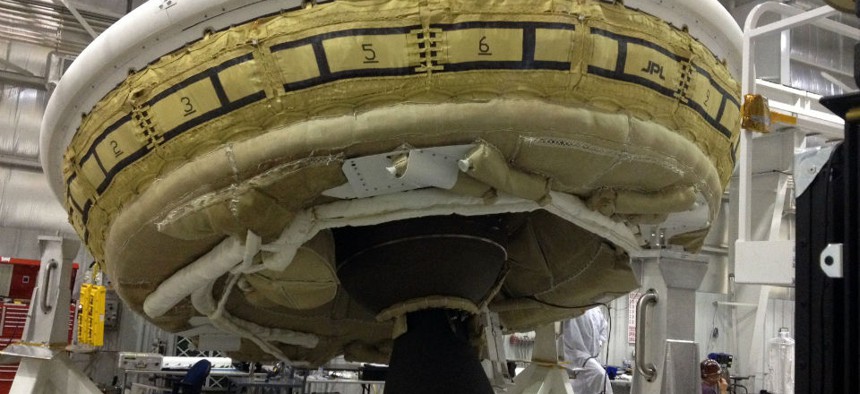NASA's Supersonic Parachute Is Running Out of Time

A saucer-shaped test vehicle holding equipment for landing large payloads on Mars in the Missile Assembly Building at the U.S Navy's Pacific Missile Range Facility. NASA/AP
Before humans can land on Mars, scientists have to wrestle with atmospheric conditions back home.
After scrapping five possible launches this month, NASA scientists have one more chance to send a supersonic parachute to the edge of space. The goal is to test flying-saucer-shaped decelerator technology that could eventually be used to help humans land on Mars. For now, though, the equipment hasn't even left Earth.
NASA ruled out possible launches for the test vehicle, named Keiki o ka honua, on June 3, June 5, June 7, June 9, and June 11, due to weather issues—mostly wind—at the U.S. Navy's Pacific Missile Range Facility on the Hawaiian island of Kauai.
"If we’re unable to fly this week, NASA will investigate options after looking at factors such as future PMRF range availability and availability of funds to extend the test timeline," NASA spokesman David Steitz told me in an email.
And though NASA scientists must be frustrated with the delay, there's something almost pleasantly humbling about our little planet's atmospheric conditions interfering with scientific ambition of this scope. Of all the barriers to get in the way of a mission that entails a stadium-sized balloon that deploys a rocket carrying a parachute designed to travel at four times the speed of sound ... regular old windis getting in the way.
In Hawaii, especially, wind is a powerful force. Along with ocean currents, it helped bring life—from coconut seedlings to human explorers—to the volcanic islands. And in a bit of irony, it's also the key weather condition in one of the other most celebrated exploration projects in the region.
Wind may be keeping NASA on the ground for now, but it is what propels the Hōkūle'a, a Polynesian voyaging canoe that—just like Keiki o ka honua—waited for the right conditions before launching last month on a three-year circumnavigation of the globe.
But while Keiki o ka honua relies on some of the most sophisticated technology in modern engineering, Hōkūle'a's feat is to use ancient navigation techniques instead—tracking bubbles on the surface of the waves and determining longitude and latitude relative to celestial maps.
And so, in both cases, explorers must rely on the wind as they look to the stars.





